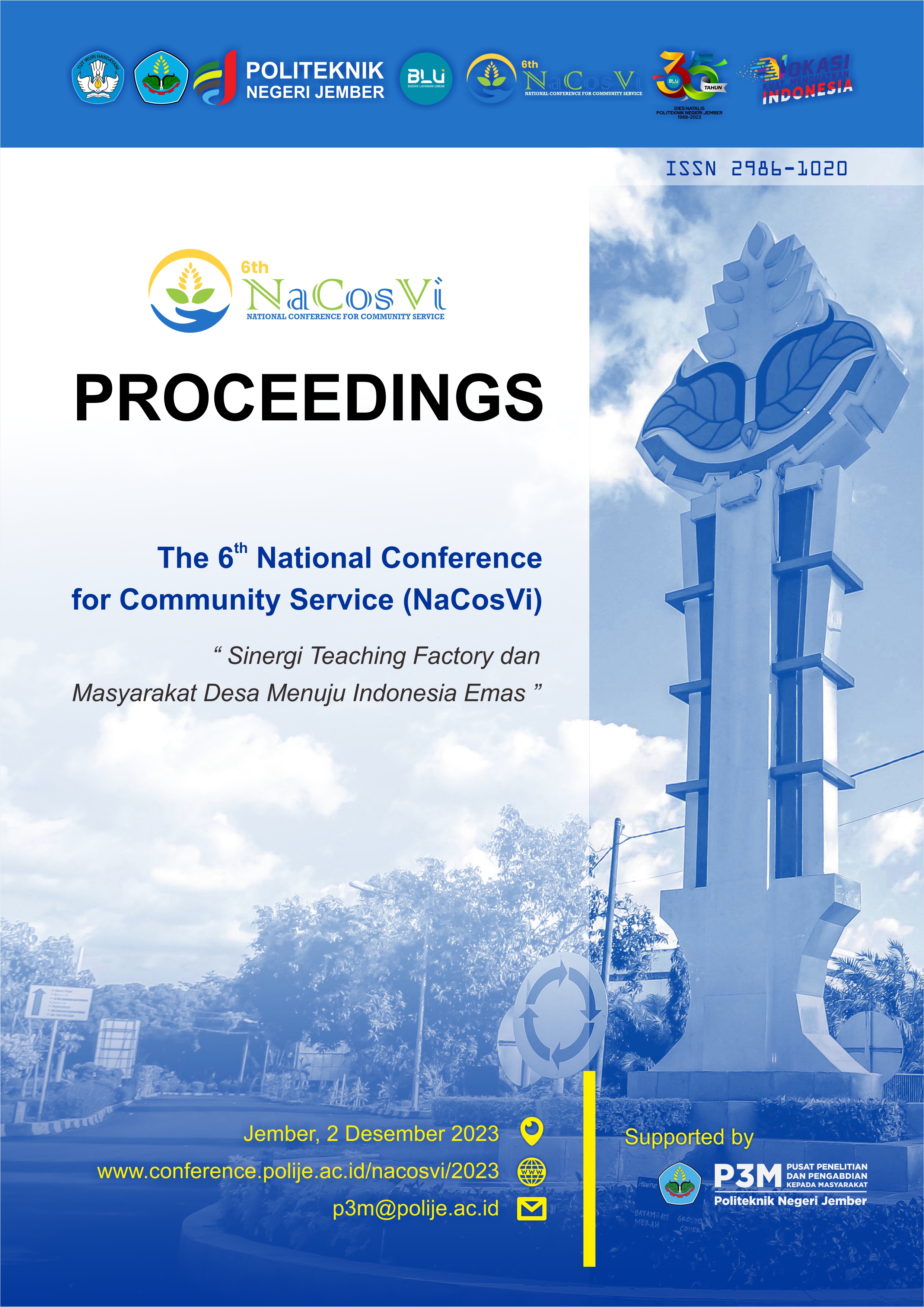Penguatan Teaching Factory (TEFA) Pengolahan Produk Kopi Politeknik Negeri Jember dalam Penerapan Good Manufacturing Practices (GMP) Guna Meningkatkan Kualitas dan Legalitas Kopi Bubuk
Strengthening the Teaching Factory (Tefa) Processing of Jember State Polytechnic Coffee Products in the Implementation of Good Manufacturing Practices (GMP) to Improve the Quality and Legality of Ground Coffee
Keywords:
Kopi bubuk, GMP, SOPAbstract
Tefa Pengolahan kopi Polije memiliki produk unggulan yaitu kopi bubuk. Adanya produk kopi bubuk dapat meningkatkan bargaining position Polije mengingat Jember menjadi kota penghasil robusta terbaik. Sayangnya, kopi bubuk tersebut hanya bisa dinikmati internal Polije dan tidak bisa diedarakan karena belum memiliki legalitas produk. Agar dapat bersaing dengan kopi bubuk dipasaran, kopi bubuk tersebut harus memiliki ijin edar yang dibuktikan dengan adanya sertifikat dari BPOM. Tahapan untuk memperoleh sertifikat BPOM adalah diterapkannya Good Manufacturing Practices (GMP) pada saat pengolahan kopi bubuk. Tefa Pengolahan kopi bubuk belum memiliki APD sehingga tidak menerapkan Kesehatan dan Keselamatan Kerja (K3) dalam setiap kali memproduksi kopi bubuk. Sementara persyaratan memperoleh legalitas hendaknya menggunakan Alat Pelindung Diri (APD). Konsistensi mutu dan kualitas kopi bubuk yang dihasilkan masih rendah dikarenakan proses produksi yang tidak konsisten. Tidak hanya dipengaruhi oleh bahan baku, proses produksi juga berperan penting. Kunci dari kualitas kopi bubuk hubungannya dengan proses produksi adalah konsistensi proses produksi. Agar dapat konsisten perlu dibuat Standard Operastional Procedure (SOP) pengolahan kopi bubuk dari setiap tahapan proses sesuai dengan GMP
Downloads
References
S. Sawada, K. Kuklane, K. Wakatsuki, and H. Morikawa, “New development of research on personal protective equipment (PPE) for occupational safety and health,” Ind. Health, vol. 55, no. 6, pp. 471–472, 2017, doi: 10.2486/indhealth.55-471.
M. C. Schall, R. F. Sesek, and L. A. Cavuoto, “barriers to the adoption of wearable sensors in the workplace: a survey of occupational safety and health professionals,” Hum. Factors J. Hum. Factors Ergon. Soc., vol. 60, no. 3, pp. 351–362, May 2018, doi: 10.1177/0018720817753907.
B. Mekonnen, N. Solomon, W. Wondimu, M. Tesfaye, and S. Negash, “Work- related disease symptoms and occupational injuries among coffee processing industry workers in Bench-Sheko and Kaffa Zones Southwest, Ethiopia: A mixed-method study,” Front. Public Heal., vol. 10, Dec. 2022, doi: 10.3389/fpubh.2022.1034957.
L. Salgueiro, A. P. Martins, and H. Correia, “Raw materials: the importance of quality and safety. A review.,” Flavour Fragr. J., vol. 25, no. 5, pp. 253–271, Sep. 2010, doi: 10.1002/ffj.1973.
U. Prajogo, M. Lutfi, Y. Liana, and S. Adi, “Evaluation of post-harvest coffee to conform with good manufacturing practices (GMP) to develop entrepreneurship,” IOP Conf. Ser. Earth Environ. Sci., vol. 475, no. 1, p. 012046, Apr. 2020, doi: 10.1088/1755-1315/475/1/012046.
P. Poltronieri and F. Rossi, “Challenges in Specialty Coffee Processing and Quality Assurance,” Challenges, vol. 7, no. 2, p. 19, Oct. 2016, doi: 10.3390/challe7020019.
J. A. Vignoli, D. G. Bassoli, and M. T. Benassi, “Antioxidant activity, polyphenols, caffeine and melanoidins in soluble coffee: The influence of processing conditions and raw material,” Food Chem., vol. 124, no. 3, pp. 863– 868, Feb. 2011, doi: 10.1016/j.foodchem.2010.07.008.
E. Firdissa, A. Mohammed, G. Berecha, and W. Garedew, “Coffee drying and processing method influence quality of arabica coffee varieties (Coffee arabica L.) at Gomma I and Limmu Kossa, Southwest Ethiopia,” J. Food Qual., vol. 2022, pp. 1–8, Apr. 2022, doi: 10.1155/2022/9184374.
A. A. Mohammedsani, “Influence of harvesting and postharvest processing methods on the quality of Arabica coffee (Coffea arabica L.) in Eastern Ethiopia,” ISABB J. Food Agric. Sci., vol. 7, no. 1, pp. 1–9, Jan. 2017, doi: 10.5897/ISABB-JFAS2016.0051.
Y. F. B. Rodriguez, N. G. Guzman, and J. G. Hernandez, “Effect of the postharvest processing method on the biochemical composition and sensory analysis of arabica coffee,” Eng. Agrícola, vol. 40, no. 2, pp. 177–183, Apr. 2020, doi: 10.1590/1809-4430- eng.agric.v40n2p177-183/2020.
M. Pranadikusumah, V. Rostwentivaivi, and A. Quddus, “Development of Good Manufacturing Practice (GMP) in the Form of a Practical-Oriented Application for Household Coffee Processing Guidelines,” in Proceedings of the 1st International Conference on Islam, Science and Technology, ICONISTECH 2019, 11-12 July 2019, Bandung, Indonesia, 2020. doi: 10.4108/eai.11-7- 2019.2297412.
F. Kulapichitr, C. Borompichaichartkul, I. Suppavorasatit, and K. R. Cadwallader, “Impact of drying process on chemical composition and key aroma components of Arabica coffee,” Food Chem., vol. 291, pp. 49–58, Sep. 2019, doi: 10.1016/j.foodchem.2019.03.152.
M. Abubakar, B. Koul, K. Chandrashekar, A. Raut, and D. Yadav, “Whitefly (Bemisia tabaci) Management (WFM) Strategies for Sustainable Agriculture: A Review,” Agriculture, vol. 12, no. 9, p. 1317, Aug. 2022, doi: 10.3390/agriculture12091317.



